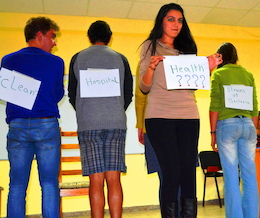Toolbox — For Training and Youth Work
All new tools in your inbox: Be the first to know about new tools for learning with our e-mail notifications.
Simulation Exercise, Exercise, Info session
Steps of Business Research
Interactive tool to creatively present the idea of Business Research and its Steps in the context of Social Entrepreneurship. By using art and historical references participants understand the purposes and idea of Business Research.
Aims of the tool
The aim of the tool is to deliver knowledge and understanding about Business Research and its Steps in the context of Social Entrepreneurship. Also to present the purpose, importance and basic methods of Business Research.
Description of the tool
Step by step tool description:
1. Participants are divided in 3 groups. Each group receives a printed story. The task is to read and present the story in 5 minutes by using any type of art method they choose (theatre, illustration, puppets, poetry etc.) so that the other groups can understand it. The stories are previously prepared to demonstrate steps of the Business Research by using real historical events. Suggested stories are below. You may choose other stories that you see appropriate to the context of the training. For example, these stories were selected to reflect a European story (previous civilizations in Europe (Spain); famous Columbus story), MEDA story (old Arabic civilization) and a current global story (contemporary research; inspiring research).
2. After presenting the stories, the trainer starts group discussion (debriefing) to analyze common points in all three stories (trying to identify the steps of research process imbedded in each story). By using guided questions the trainer focuses the thinking of participants on the different stages that are common in all stories (the Steps). Group also discusses importance of each step for achieving final result in the stories.
Suggestions for questions to highlight during the debriefing:
• What was the “problem” they were trying to solve for each story?
• Was there any previous work they tried to rely on to solve the “problem”; any previous knowledge?
• For each story, what were they trying to find (purpose of research)?
• What steps did they take to achieve their purpose?
• Describe the process and any data collected/ findings?
• Were there any interpretations for their findings?
• Did they share their findings? How?
3. Then the trainer gives a presentation to reinforce the information previously discussed. After concluding all needed stages that have to be implemented in each story to achieve the result theory of the Business Research purpose, importance, basic methods and steps are presented by the trainer.
4. Conclusion of the debriefing and presentation: After theory presentation participants are asked to make connections between it and the conclusion would be that conducting research is a prerequisite for establishing social entrepreneurship.
Available downloads:
Disclaimer
SALTO cannot be held responsible for the inappropriate use of these training tools. Always adapt training tools to your aims, context, target group and to your own skills! These tools have been used in a variety of formats and situations. Please notify SALTO should you know about the origin of or copyright on this tool.
Tool overview

http://toolbox.salto-youth.net/1489
This tool addresses
Project Management, Organisational Management
It is recommended for use in:
Action 1.1 (Youth Exchanges)
Action 4.3 (Training and Networking)
Materials needed:
Printed stories, Materials for creative presentation of the stories (costumes, colored papers, crayons, scissors etc.), Handouts or PPT for theory presentation;
Duration:
180 min
Behind the tool
The tool was created by
Iyad Aljaber (Jordan) and Ognian Gadoularov (Bulgaria)
in the context of
Training course “Environment, Sustainability and Youth – entrepreneurship and development in rural areas” (BG13/A3.1.2/270/R2), 28.10 – 05.11.2013 – Smolyan, Bulgaria
The tool has been experimented in
Training course “Environment, Sustainability and Youth – entrepreneurship and development in rural areas” (BG13/A3.1.2/270/R2), 28.10 – 05.11.2013 – Smolyan, Bulgaria
The tool was published to the Toolbox by
Ognian Gadoularov (on 14 January 2014)
and last modified
22 December 2013
Comments
No comments have been posted yet.
If you want to comment on this tool, you need to be signed in with your MySALTO account. Sign in now